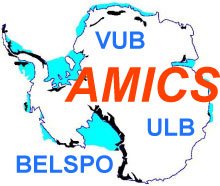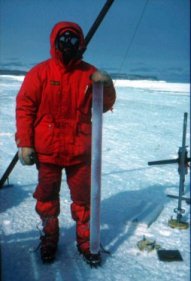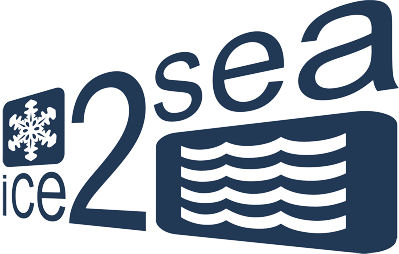
Laboratoire de Glaciologie - ULB
ICE 2 SEA
| The melting of continental ice
(glaciers, ice caps and ice sheets) is a
substantial source of current sea-level rise, and
one that is accelerating more rapidly than was
predicted even a few years ago. Indeed, the most
recent report from IPCC highlighted that the
uncertainty in projections of future sea-level
rise is dominated by uncertainty concerning
continental ice, and that understanding of the
key processes that will lead to loss of
continental ice must be improved before reliable
projections of sea-level rise can be produced.
The ice2sea programme will draw together European
and international partners, to reduce these
uncertainties. More information HERE. |
ICECUBE-DYNDeep ice behaviour and subglacial linkages within IceCube, Antarctica (2008-2012)IceCube is a cubic kilometre large neutrino observatory under construction at the Amundsen-Scott South Pole Station. Like its predecessor, the Antarctic Muon And Neutrino Detector Array (AMANDA), IceCube is being constructed in deep Antarctic ice by deploying thousands of spherical optical sensors (photomultiplier tubes, or PMTs) at depths between 1,450 and 2,450 meters. The sensors are deployed on "strings" of sixty modules each, into holes melted in the ice using a hot water drill. The IIHE laboratory of the ULB is strongly involved in this project. More information on Frank Pattyn's page : HERE |
 |
NEEM
North Greenland Eemian Ice Drilling (2007-2011)
NEEM is an international ice core research project aimed at retrieving an ice core from North-West Greenland (camp position 77.45°N 51.06°W) reaching back through the previous interglacial, the Eemian. The project logistics is managed by the Centre for Ice and Climate, Denmark, and the air support is carried out by US ski equipped Hercules managed through the US Office of Polar Programs, National Science Foundation.
More information HERE.
ASPI
Antarctic Subglacial Processes and Interactions (2005-2009)
Role of transition zones in ice sheet stabilityThe aim of ASPI (Antarctic Subglacial
Processes and Interactions) is ASPI is the follow-up of AMICS. More information on Frank Pattyn's page : HERE |
ISMIP-HOM
Ice Sheet Model Intercomparison Project for Higher-Order ice sheet Models (2006-2008)
Conveners
- Frank PATTYN, Laboratoire de Glaciologie, Départment des Sciences de la Terre et de l'Environnement, Université Libre de Bruxelles, CP 160/03, Av. F.D. Roosevelt 50, 1050 - Bruxelles (email: fpattyn@ulb.ac.be)
- Tony PAYNE, Bristol Glaciology Centre, School of Geographical Sciences, University of Bristol, Bristol B88 1SS, England (email: a.j.payne@bristol.ac.uk)
More information on Frank Pattyn's page : HERE
SIBClimSea Ice Biogeochemistry in a CLimate change perspective (2002-2007)This research project aims to assess to which extent ice-covered polar oceans contribute to processes regulating the Earth’s climate. It involves a new multidisciplinary consortium combining the expertise of glaciologists, biologists, geochemists and ecosystems-modelers of the Université Libre de Bruxelles (ULB).The main goal of the project is to study,understand and quantify the physical and biogeochemical processes associated with the sea ice biota that govern the emissions of marine gases of climatic significance. |
 |
AMICS
Antarctic ice-sheet dynamics and climatic change: Modelling and Ice Composition Studies (2000-2005)
 |
The main objective of AMICS
(Antarctic ice-sheet dynamics and climatic
change: Modelling and Ice Composition
Studies) network proposal is to contribute
to the international research effort leading to
an improved understanding of the dynamic
behaviour of the Antarctic ice sheet resulting
from climatic change. More specifically it aims
at a better knowledge of the internal dynamics of
the Antarctic ice sheet and to a better
assessment of the interactions of the ice sheet
with its boundary conditions. The major
components of this interdisciplinary research
objective are modelling and ice composition
studies. More information on Frank Pattyn's page : HERE |
EPICAEuropean Project for Ice Coring in AntarcticaThe main objective of EPICA is to
obtain a full documentation of the climatic and
atmospheric record archived in Antarctic ice by
drilling and analyzing two ice cores. It is the
goal to get from these records and especially
from comparisons of the records with their
Greenland counterparts information about the
natural climate variability and about the
mechanisms of fast climatic changes. |
INTERICE
Interdisciplinary Ice tank Experiment (1998- 2001 and ongoing)
INTERICE is a multidisciplinary ice tank study, involving an international team of scientists (Belgium, Germany, Norway, the United Kingdom, Finland, The United States.). The ice tank offers the possibility of refining field measurements by carrying out experiments under fully controlled environmental conditions. Work on physical, biogeochemical, and sedimentological aspects of growth processes of artificial sea ice using the large indoor tank complement observations from both the Arctic and the Antarctic. Tank experiments have several advantages over field investigations.
Lake Vostok
Basal Ice at Lake Vostok (2000- ongoing)
Our laboratory is actively involved in the
interpretation of the physico-chemical properties of the
basal ice of the Vostok ice core. A geochemical
investigation of the deepest part of the Vostok ice core
between 3310 m, the depth at which the
palaeoenvironmental record present in the ice above is
lost, and the bottom of the core about 130 m above
subglacial Lake Vostok reveals two contrasted sections.
The upper section (3310- 3539 m depth) still consists of
ice of meteoric origin but subjected to widespread
complex deformation. This deformation has been analyzed
in light of a dD- deuterium excess diagram and
information on microparticles, crystal sizes and chemical
elements distributions in that part of the core. Such ice
deformation occurred when the ice was still grounded
upstream from Vostok Station, in a region with
subfreezing temperatures.
The lower section from 3539 m to the bottom of the core
at 3623 m depth is lake ice formed by freezing of
subglacial Lake Vostok waters. This is indicated by the
isotopic properties (dD, d18O and deuterium excess), by
electrical conductivity measurements (ECM),
crystallography and gaz content of the ice. These ice
core data together with data on ionic chemistry favor an
origin of the lake ice by frazil ice generation in a
supercooled (below pressure melting point) water plume
existing in the lake followed by accretion and
consolidation by subsequent freezing of the host water.
BIFTeG
Basal Ice Facies of Temperate Glaciers (1997-ongoing)
This project is probably the longest-lived of our laboratory. It has been looking at the basal layer of various types of alpine glaciers from the Swiss-French-Italian Alps, using the multiparametric approach of ice properties (ice fabrics and textures, ice chemistry, stable isotopes, solid impurity content a.s.o). to decipher boundary conditions at the ice-bedrock interface. We are looking at an array of topics such as: subglacial hydrology, glacial erosion processes, chemical sorting effect in sediment loaded ice, debris incorporation a the glacier bed, carbonate precipitates on subglacial floors, ice deformation around obstacles, inherited characteristics of proglacial streams.
ISMIce
 |
Ice Shelf Marine Ice (1992- ongoing)This research project deals with ice-ocean interactions at ice sheet boundaries. The main goal of the project is to study, understand and quantify how ice shelves stability is affected by interactions with ocean water masses, in a changing climate perspective. Focus is put on what is known as "marine ice" i.e. ice formed in the water column below or at the front of ice shelves, as a result of thermohaline circulation loops affecting the water masses in the sub-ice shelf cavity. This ice then floats up and accretes at the bottom of the ice shelf and potentially acts as a welding agent of the large crevasses forming either at the grounding line (where the ice shelf gets afloat) or at ice shelf fronts (degenerating into rifts as iceberg calving proceeds). |

